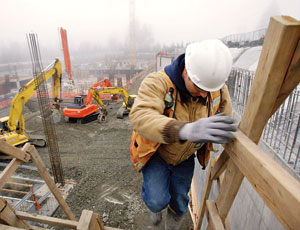As organized labor heads into a potentially dismal negotiation season this year, unions received a big boost in February when President Barack Obama made good on his campaign promise to reverse the ban on project labor agreements for federally funded projects. As billions of dollars in federal work begins to filter out through the stimulus package, federal contracting agencies could opt to use project labor agreements on its major construction projects.

Under the order, agencies are given the option of using PLAs on projects valued at $25 million or more. The order reinstates many of the same provisions for use of PLAs that were in place under the Clinton administration. Project labor agreements on federal jobs were banned by the Bush administration in 2000.
Despite the order, there are numerous questions about how widespread the use of PLAs could be and its potential impact on costs. Shortly after the order was signed on Feb. 6, Kirk Pickerel, president of Associated Builders and Contractors, Arlington, Va., claimed such agreements could raise project costs by 10% to 20% and would discriminate against the 84% of construction workers who are non-union.
Unions point to Nationals Park in Washington, D.C., the new $611-million stadium for the Major League Baseball’s Washington Nationals that was completed in 2008, as a project that achieved success using a project labor agreement. Anthony Frederick Sr., business manager with Laborers Local #657, which covers the District of Columbia and five neighboring counties in Maryland, says the PLA benefited local workers by guaranteeing them an opportunity to receive fair wages and benefits.
“Without a PLA, you see contractors bring in workers from everywhere and not let the locals do the work,” he says.
Frederick says using such provisions under project labor agreements guarantee a portion of work to local laborers and is in the spirit President Obama’s efforts to create jobs.
However, a study released in October 2007 by the District Economic Empowerment Coalition claimed that although the Nationals Park PLA called for 50% of journeymen hours to be mandated for D.C. residents, only 29% of such hours actually went to D.C. workers.
Although ABC calls the renewed PLA option discriminatory, Tom Owens, spokesperson for the Building & Construction Trades Dept. of the AFL-CIO, says reversing the ban does not automatically shut out open-shop contractors. “It’s illegal to prohibit anyone from bidding on these jobs,” he says. “There are numerous situations out there where open shop and union are both on a PLA job.”
Denise Gold, associate general counsel for labor and employment law at Associated General Contractors, Arlington, Va., argues that using a PLA could create a chilling effect for many contractors. Gold notes that many contractors either don’t know how to work under a PLA or may face significant hurdles, such as conflicting benefits programs, which would prevent them from bidding on work.
“We’re hopeful that the government will stay neutral as permitted under the new executive order and let the contractors, as employers, and their employees decide if they want to do a PLA,” she says.
Whether or not PLAs emerge as a boon for union journeymen, it marks a moral victory in what could otherwise be a devastating season for labor negotiations. Bob Gasperow, executive director of the Construction Labor Research Counsel in Washington, D.C., notes that first year settlements were still historically high in 2008, averaging 4.5%. That is an unsustainable pace in the current economic downturn, he believes, pointing out that historically contracts also get shorter during recessions.
“This spring and summer, there are more question marks then we’ve seen in years,” he says. “It’s highly unlikely that settlements can continue as they have in recent years.”

Post a comment to this article
Report Abusive Comment